Google sits at the heart of our digital lives, acting as the ultimate guide to information, products, and services. In 2025, it continues to dominate the online world, processing an astounding number of searches every single day.
If you want to connect with your audience, understanding these search patterns is absolutely essential.
This detailed guide breaks down the latest Google search statistics for 2025, showing you how people use Google and how you can leverage these insights for your benefit.
Table of Contents
ToggleGoogle Search Statistics 2026: Key Takeaways

- Massive Scale: Google handles an estimated 16.4 billion searches per day in 2025, translating to over 5.9 trillion searches annually.
- Market Dominance: Google commands a staggering 90.14% of the global search engine market.
- Mobile-First World: A significant 60% of all Google searches originate from mobile devices, with Google holding a 94.21% share of the mobile search market.
- Voice and Visual are Booming: Voice search makes up almost 1 in 5 Google searches, and Google Lens processes around 12 billion visual searches every month.
- Local Intent is High: Nearly half of all Google searches have local intent, leading to offline purchases 78% of the time on mobile.
- SEO is Non-Negotiable: The first position on Google search results bags an average click-through rate of 27.6%, while 75% of users never go past the first page.
Let’s dive into the numbers and discover how you can use them to your advantage!
How Many Google Searches Happen Every Single Day?
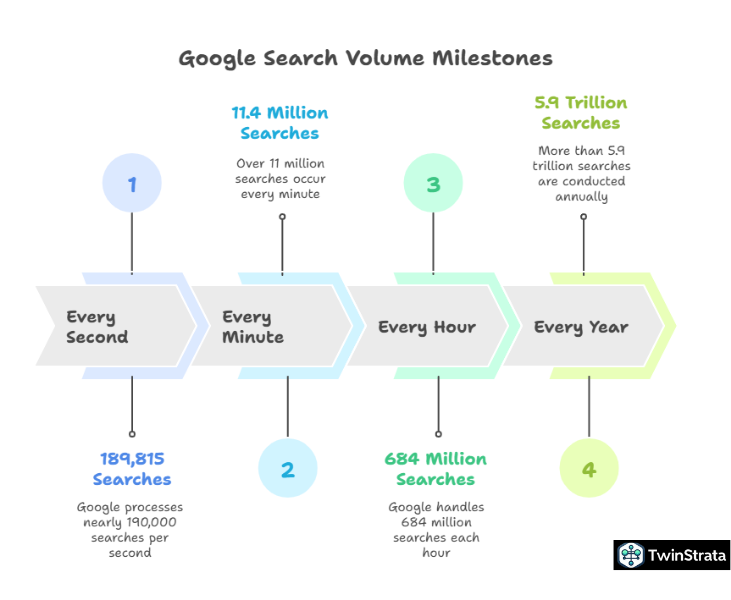
Imagine billions of questions, millions of curiosities, and countless needs being typed or spoken into a search bar – that’s Google’s daily reality. In 2025, Google processes an estimated 16.4 billion searches every single day. This massive number shows just how integrated Google is into our daily routines, whether we’re looking for quick facts, shopping for products, or finding local businesses.
Think about that for a moment:
- Every second: Google handles approximately 189,815 searches.
- Every minute: About 11.4 million searches fly through its systems.
- Every hour: A staggering 684 million searches take place.
- Every year: This totals over 5.9 trillion searches globally.
While Google itself stopped releasing official daily search figures back in 2016, these 2025 estimates, based on growth trends, reveal a dramatic increase in search volume, highlighting Google’s ever-growing role in connecting people with information.
Here’s a quick look at Google’s estimated search growth over the years:
| Year | Estimated Google Searches Annually |
| 1999 | 1 billion |
| 2000 | 14 billion |
| 2001–2003 | 55 billion |
| 2004–2008 | 73 billion |
| 2009 | 365 billion |
| 2012–2015 | 1.2 trillion |
| 2016–2023 | 2 trillion |
| 2024 | 5 trillion |
| 2025 | 5.9 trillion |
Source: Search Engine Land
This continuous growth isn’t just a number; it represents an expanding opportunity for businesses and content creators to reach potential customers and readers.
With approximately 5.01 billion people using Google globally in 2025, it’s clear that the search engine serves a vast and diverse audience. This accounts for a substantial portion of the world’s 5.65 billion internet users.
On average, a person conducts about 2.8 searches per day. However, this average hides a lot of interesting behavior:
- Frequent Searchers: A notable 34% of people perform more than 100 searches each month. These are your power users, constantly seeking information.
- Regular Searchers: Another 36% search between 21 and 100 times monthly.
- Occasional Searchers: Around 30% make just 1 to 20 searches a month.
In the United States, desktop users are particularly active, averaging about 126 unique searches per month, which works out to around 4.2 searches per person per day.
Most people gravitate towards Google’s main search page, with 86.94% of Americans starting their search there. However, other Google services also capture significant attention:
| Google Search Vertical | Percentage of Searches |
| Main Search Page | 86.94% |
| Images | 10.62% |
| Video | 1.16% |
| Maps | 0.64% |
| News | 0.38% |
| Shopping | 0.23% |
| Web | 0.04% |
What does this mean for you? Optimize your content not just for text searches but also for images and videos. If you have a local business, ensure your Google Maps listing is impeccable.
- Also read about: Internet Usage Statistics
What Are People Searching For? The Most Popular Queries
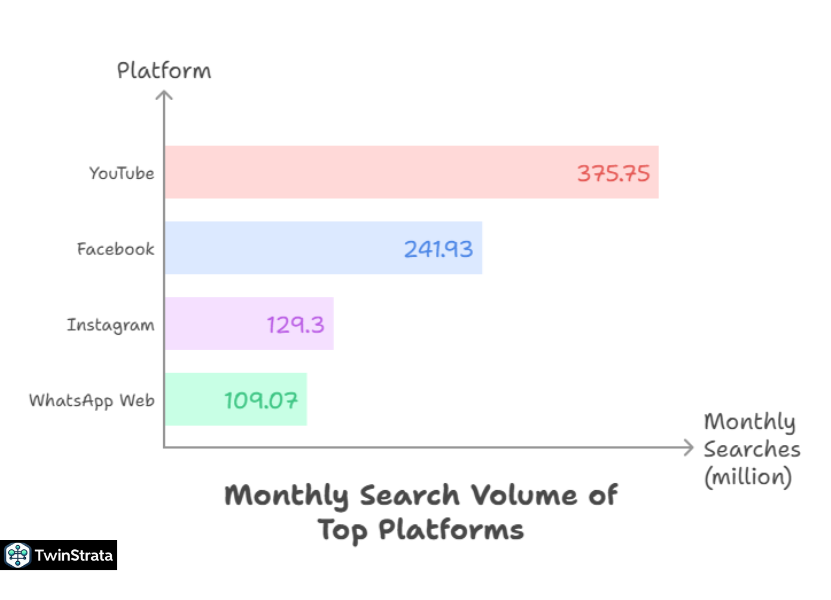
Understanding what people search for gives you a direct line into their interests and needs. In 2025, certain terms consistently capture massive attention.
“YouTube” stands as the undisputed king of search terms, pulling in an impressive 375.75 million searches per month. This highlights the immense demand for video content and YouTube’s position as a global entertainment and information hub.
Social media platforms also dominate the top searches, reinforcing our need for connection and communication:
- Facebook: 241.93 million monthly searches
- Instagram: 129.3 million monthly searches
- WhatsApp Web: 109.07 million monthly searches
E-commerce giant Amazon secures the third spot with 176.44 million monthly searches, solidifying its role as the world’s leading online marketplace.
Here’s a breakdown of the top 10 most searched terms globally:
| Rank | Search Term | Average Monthly Search Volume |
| 1 | youtube | 375,751,580 |
| 2 | 241,926,500 | |
| 3 | amazon | 176,446,250 |
| 4 | translate | 150,472,990 |
| 5 | weather | 147,678,760 |
| 6 | 129,303,360 | |
| 7 | chatgpt | 125,739,030 |
| 8 | gmail | 110,366,650 |
| 9 | whatsapp web | 109,074,380 |
| 10 | nba | 84,255,310 |
Source: Statista, Stats Counter
Your Action Plan: Align your content strategy with these popular interests. If you create videos, optimize them for YouTube. If you sell products, consider your Amazon strategy. Use tools like ChatGPT? People are actively searching for it!
The Rise of Conversational and Visual Search: Voice and Lens
The way we search is evolving. Typing keywords is no longer the only game in town. Voice commands and visual queries are rapidly gaining traction, changing how users interact with Google.
1. Google Voice Search
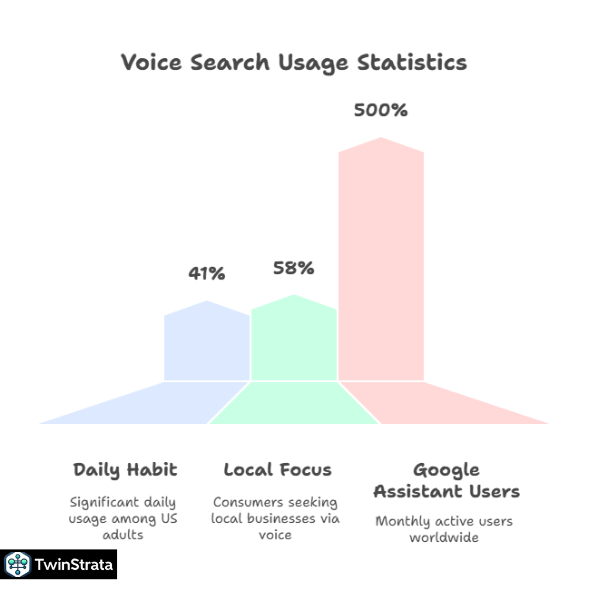
Voice search is on the rise, driven by convenience and the proliferation of smart devices. Nearly 1 in 5 Google searches now happen through voice.
Google Home, for example, boasts an impressive 81% accuracy rate for voice queries, making it a reliable tool for users.
- Daily Habit: A significant 41% of adults in the US use voice search daily.
- Local Focus: Approximately 58% of consumers use voice search to find local businesses. This is a huge opportunity for local SEO!
- Google Assistant Dominance: Google Assistant is a major player, with 500 million people worldwide using it every month. It’s predicted to outnumber Siri and Alexa users in the US.
The increasing comfort with voice assistants means your content needs to be optimized for conversational queries. Think about how someone would ask a question rather than type a keyword.
2. Google Lens: Searching with Your Camera
Google Lens allows you to search by pointing your smartphone camera at objects, text, or images. This technology is incredibly powerful for product discovery, text translation, and information gathering.
- Massive Usage: Users conduct around 12 billion visual searches monthly through Google Lens.
- Real-time Recognition: Google Lens can identify up to a billion different items.
- More Than Just Images: It extracts text, translates languages, and helps you find similar products.
How to Leverage Lens:
- High-Quality Images: Ensure your website features excellent, relevant images.
- Keyword-Rich Title Tags: Interestingly, 32.5% of Google Lens results have a matching keyword in the page’s title tag. Optimize your titles!
- Top-Ranking Pages: About one-third of Google Lens image results come from the top 25% of web pages. This emphasizes the importance of overall SEO.
- Pinterest and Amazon Power: 7.2% of Google Lens results come from Pinterest, and 4.1% from Amazon. If you sell products, these platforms are crucial for visual search discovery.
Mobile-First is No Longer a Trend, It’s the Standard
With over 7 billion smartphones in use globally, it’s no surprise that mobile devices are the primary way many people access Google.
- Dominant Force: A staggering 60% of all Google searches now come from mobile devices. This volume has doubled in just five years!
- Market Share: Google holds an overwhelming 94.21% share of the mobile search engine market.
- Organic Traffic: In the US, 63% of Google’s organic search traffic originates from mobile devices.
- Local Intent on Mobile: Smartphone users are much more likely to conduct local searches, seeking nearby businesses or quick answers to location-based queries.
Mobile Optimization is Critical:
- Responsive Design: Your website must look and function perfectly on all screen sizes.
- Fast Loading Speed: Mobile users expect quick results. Slow sites lead to high bounce rates.
- Local SEO: Given the high volume of local mobile searches, make sure your business information is accurate and easily discoverable.
The Power of Local Search: Connecting Online to Offline
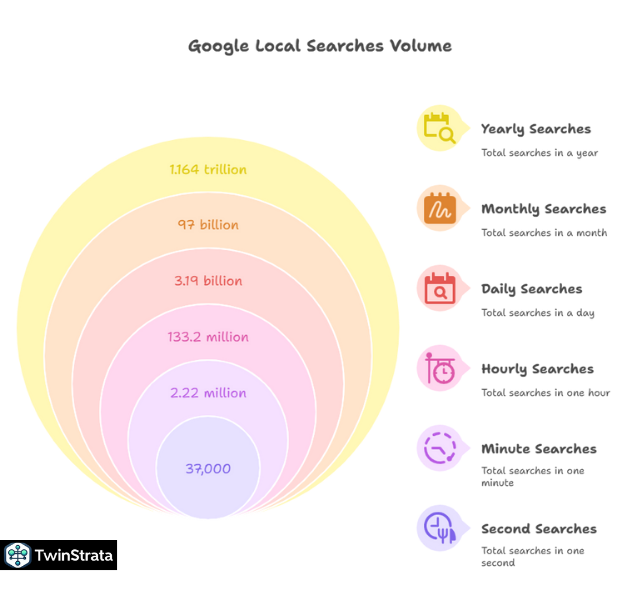
Google isn’t just for global information; it’s a powerful tool for finding things right around the corner. Nearly half of all monthly Google searches (46%) have local intent. This translates to an incredible 97 billion local searches per month, or 3.19 billion daily local searches.
| Time Frame | Number Of Local Searches On Google |
| Per second | 37,000 |
| Per minute | 2.22 million |
| Per hour | 133.2 million |
| Per day | 3.19 billion |
| Per month | 97 billion |
| Per year | 1.164 trillion |
The Conversion Power of Local Search:
- Offline Purchases: An impressive 78% of local mobile searches on Google result in an offline purchase. Even more compelling, 90% of these purchases happen in physical stores.
- In-Store Research: 56% of in-store shoppers use their smartphones to research items while they are shopping.
What You Need to Do: Develop a robust local SEO strategy. Optimize your Google Business Profile, get local reviews, and ensure your business appears in “near me” searches. This is where online presence directly translates into real-world sales.
The Search Landscape for Products: Google vs. Amazon
While Google remains a primary starting point for general searches, the landscape for product discovery is shifting.
- Historically, 46% of product searches began on Google.
- However, recent data shows that Amazon has surpassed Google, with 54% of searches now starting directly on Amazon when people are looking to buy something.
Your Strategy: If you sell products, a dual strategy is key. Use Google for broad brand awareness and content that answers buyer questions, but also ensure a strong presence and optimization on Amazon for direct product searches.
The Impact of AI Overviews
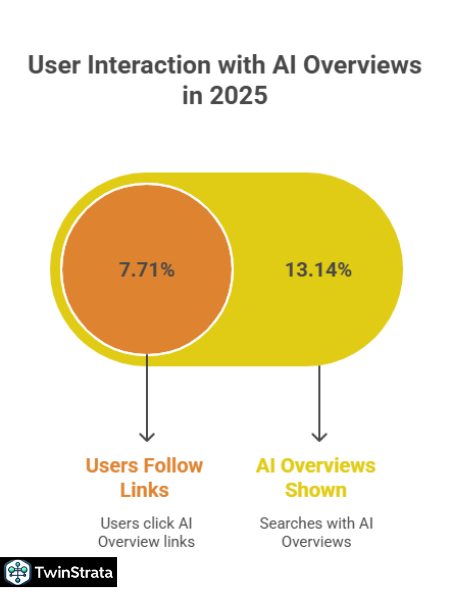
Artificial Intelligence (AI) is already changing the search results page. In 2025, AI Overviews appear in 13.14% of all Google searches, nearly doubling their presence since January 2025.
However, user interaction with these AI-generated summaries is still evolving:
- Only 7.71% of users follow the links provided by AI Overviews.
- 8.5% of users trust the information presented in AI Overviews.
This indicates that while AI provides quick answers, users still often seek out original sources for more detailed information or verification. This reinforces the importance of high-quality, authoritative content on your website.
Why SEO (Search Engine Optimization) is More Important Than Ever
The sheer volume of Google searches means massive opportunities for your website, blog, or business. However, simply existing online isn’t enough. You need to be visible, and that’s where SEO comes in.
1. The Unforgiving Nature of the First Page
The statistics are stark:
- A staggering 75% of people never go past the first page of Google search results. If your website isn’t there, a vast audience misses out on finding you.
- Only a tiny fraction, 0.63% of users, click on the second page.
2. The Power of Position #1
The top spot on Google is highly coveted for a reason:
- The result in the #1 position on Google’s search results has an average click-through rate (CTR) of 27.6%.
- This drops significantly for lower positions.
Here’s a clear picture of how CTR changes based on search result position:
| Google Search Result’s Position | CTR Rate Recorded By Result |
| #1 | 27.6% |
| #2 | 15.8% |
| #3 | 11.0% |
| #4 | 8.4% |
| #5 | 6.3% |
| #6 | 4.9% |
| #7 | 3.9% |
| #8 | 3.3% |
| #9 | 2.7% |
| #10 | 2.4% |
This data clearly shows that investing in SEO to reach the top positions is not just beneficial, it’s essential for driving traffic and connecting with your audience.
3. Starting Points for Online Experiences
Around 93% of online experiences begin with a search engine like Google. This statistic alone should convince any business owner or content creator that being visible on Google is fundamental to success. Without a strong presence, you risk missing out on a massive pool of potential customers.
New Insights from Reddit and Quora: What Users Are Asking
To bring you the latest, most relevant information, we’ve scoured communities like Quora and Reddit to understand the burning questions users have about Google searches in 2025. Here’s what’s trending:
1. “How do I deal with AI Overviews taking up space?” Many users are noticing the increased presence of AI Overviews (formerly SGE) and wondering if it’s impacting their ability to find traditional search results quickly. Some express frustration that the AI summary sometimes misses the mark or pushes organic results further down.
- Insight for You: While AI Overviews provide quick answers, users still click through to source websites. Focus on creating comprehensive, authoritative content that AI Overviews can confidently summarize, and ensure your site offers additional value (deeper dives, unique perspectives) that encourages users to visit.
2. “Are long-tail keywords still important with voice search?” People are questioning if the rise of conversational voice search makes traditional keyword research less relevant.
- Insight for You: Yes, long-tail keywords are more important. Voice searches are naturally longer and more conversational. Optimize for natural language questions (“How do I fix a leaky faucet?” instead of “leaky faucet fix”). This aligns perfectly with how people speak into their devices.
3. “Is Google Discover a new SEO frontier?” Many are curious about Google Discover and how to get their content featured.
- Insight for You: Absolutely! Google Discover, with over 800 million monthly users, offers a unique opportunity. It focuses on user interests, so producing high-quality, engaging content, especially news, evergreen articles, and visually appealing posts (with great images), can help you get seen. Content on Discover often has a short lifespan (3-4 days), so consistent content creation is key.
4. “What’s the best way to get seen by Google Lens?” Users are trying to understand how to optimize for visual searches.
- Insight for You: Focus on high-quality, clear product images and ensure they have descriptive alt text. As mentioned, keyword-optimized title tags for pages with relevant images also help. If you have products, consider a strong presence on Pinterest and Amazon, as Lens frequently pulls from these platforms.
5. “Is it worth it to run Google Ads when organic traffic is so hard to get?” Businesses are weighing their options.
- Insight for You: Google Ads can be highly effective, with businesses seeing an average $8 return for every $1 spent. It provides immediate visibility. However, SEO builds sustainable, long-term traffic and credibility. A balanced approach, using ads for immediate impact and SEO for continuous growth, often yields the best results.
FAQs About Google Search Statistics
1. How many Google searches happen per day in 2025?
In 2025, Google processes an estimated 16.4 billion searches per day, showcasing its continued dominance and integration into daily online activities worldwide.
2. Why is Google's market share so high compared to other search engines?
Google maintains its incredibly high market share, over 90%, due to its superior search algorithms that provide highly relevant results, its vast ecosystem of services like Maps, YouTube, and Gmail, and continuous innovation in search technology.
3. How can I use these Google search statistics to improve my website's visibility?
You can improve your website’s visibility by focusing on mobile-friendliness, optimizing for local search queries, creating high-quality content that answers common questions (including conversational voice search queries), ensuring your images are well-optimized for visual search, and diligently working on SEO to rank on the first page of search results.
4. What does "local intent" mean in Google searches, and why is it important?
“Local intent” refers to searches where the user is looking for information related to a specific geographic location, such as “restaurants near me” or “plumbers in [city].” It is crucial because a high percentage of these searches (78% on mobile) lead directly to offline purchases, making local SEO vital for physical businesses.
5. Are voice search and Google Lens really changing how people search?
Yes, voice search and Google Lens are significantly changing search behavior. Voice search accounts for nearly 1 in 5 Google searches and is growing, driven by convenience. Google Lens processes billions of visual searches monthly, allowing users to search with their camera, indicating a shift towards more intuitive, non-text-based queries.
Also Read:
- Social Media Statistics
- Digital Marketing Statistics
- Deepseek AI Statistics
- Affiliate Marketing Statistics
- X Twitter Statistics
Conclusion: Google’s Unwavering Influence and Your Path to Success
Google’s role in our digital lives is undeniable and continues to grow. In 2025, it handles approximately 16.4 billion searches every day, a testament to its massive reach and indispensable nature.
With over 5 billion users worldwide, Google remains the gateway to information, making a strong presence on this platform critical for anyone seeking to connect with an audience.
The insights from this data are clear: a mobile-first, locally-aware, and visually-optimized strategy, underpinned by robust SEO, is essential.
Embrace the rise of voice and visual search, and always remember that while AI provides quick answers, high-quality, comprehensive content from reliable sources will always encourage users to click through.
